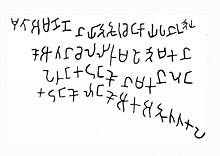Thagadur Erinta
| Perum Cheral Irumporai | |
|---|---|
| Thagadur Erinta | |
 Pugalur inscription Pugalur inscription | |
| Issue | Ilam Cheral Irumporai |
| House | Chera |
| Father | Chelva Kadumgo Vazhi Athan |
Perum Cheral Irumporai, known as Perum Kadungon, was a member of the Irumporai line of the Chera dynasty in early historic south India (c. 1st - 4th century CE). He is the hero of the eighth chapter of the Pathitruppathu composed by poet Arichil Kizhar. He is also addressed as "Kothai Marpa" in the Tamil songs.
He probably was a member of the Irumporai/Porai line, a collateral branch of the Chera family (dominating the Kongu country with Karuvur/Karur as their headquarters). Chelva Kadungo Vazhi Athan, father of Perum Cheral, was praised for his possession of Kodumanam (present-day Kodumanal) and Pandar (Koyilandy?) on the Malabar Coast.
He is famous for the victory over Thagadur Adiyaman chieftain Ezhini. He also seems to have defeated a minor Idayar chief called Kazhuval or Kazhuvul He is praised as the overlord of Pukar, the Chola capital, the Kolli hills and Puzhi Nadu region.
Perum Cheral is sometimes identified with Perum Kadungon, the Irumporai Chera royal mentioned in the two near-identical Pugalur inscriptions. The inscriptions record the construction of a rock shelter for Chenkayapan, a Jain monk on the occasion of the inauguration of Kadungon Ilam Kadungo, son of Perum Kadungon, the son of king Athan Chel Irumporai/Irumpurai as the heir apparent ("Ilamgo"). The three Chera royals can be identified with Chelva Kadungo Vazhi Athan, Perum Cheral Irumporai and Ilam Cheral Irumporai mentioned in the early Tamil literature (decades 7-9, Pathitruppathu Collection).
References
- ^ Pletcher, Kenneth, ed. (2024). "Cera dynasty". Encyclopædia Britannica.
- ^ Mahadevan, Iravatham (2003). Early Tamil Epigraphy: From the Earliest Times to the Sixth Centuy AD. Harvard Oriental Series. Cre-A and Harvard University. pp. 117–119.
- ^ Zvelebil, Kamil (1973). The Smile of Murugan: On Tamil Literature of South India. Leiden: E. J. Brill. pp. 40 and 52-53.
- ^ Aiyar, K. G. Sesha (1937). Chera Kings of the Sangam Period. London: Luzac and Co. pp. 41–43.
- ^ Subbarayalu, Y. (2014). "Early Tamil Polity". In Karashima, Noburu (ed.). A Concise History of South India: Issues and Interpretations. New Delhi: Oxford University Press. pp. 49–50.
- Champakalakshmi, R. (2003). "A magnum opus on Tamil-Brahmi inscriptions". Frontline Magazine.
This Indian history-related article is a stub. You can help Misplaced Pages by expanding it. |
This biography of a member of an Indian royal house is a stub. You can help Misplaced Pages by expanding it. |